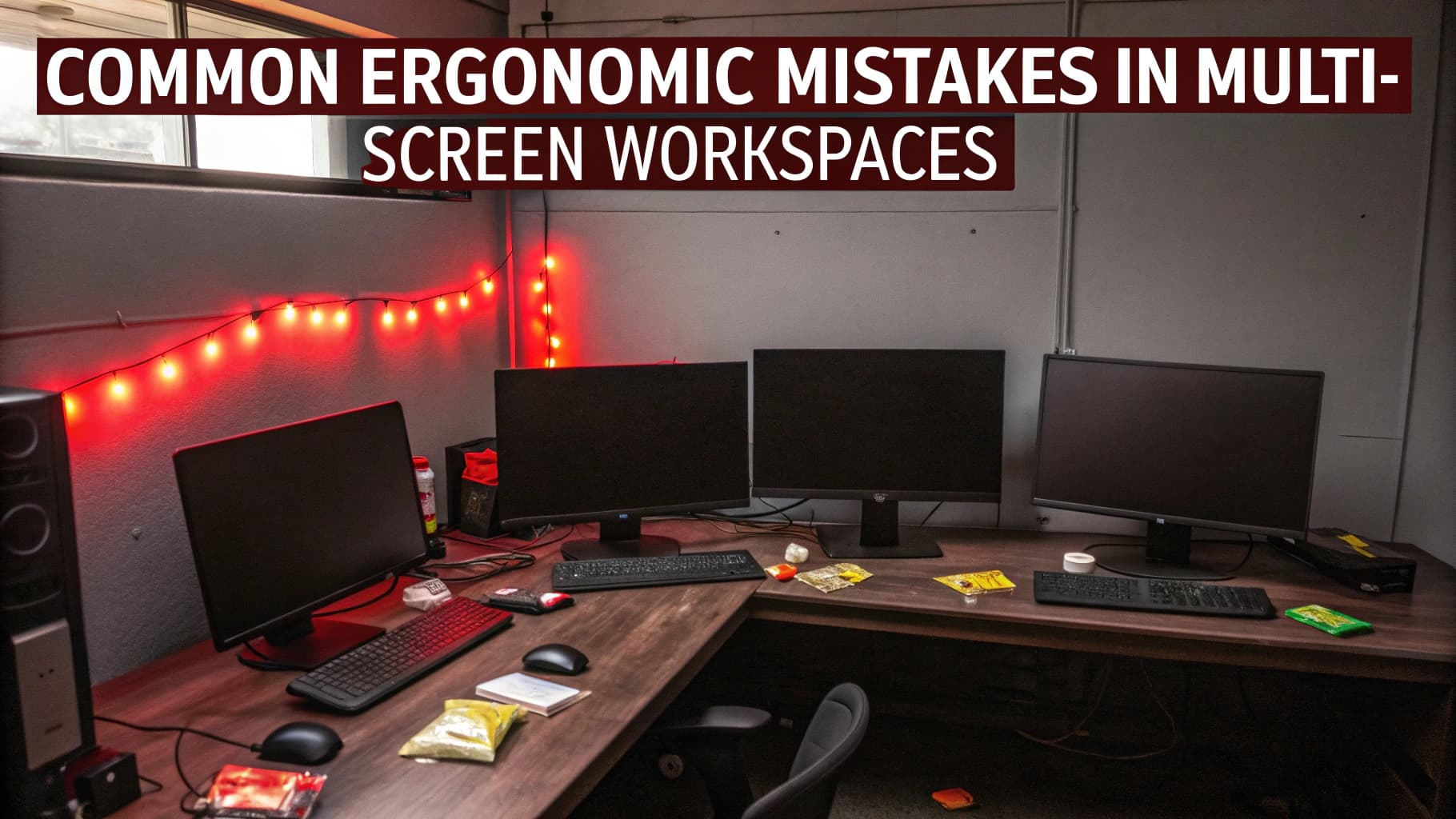In today’s fast-paced digital world, the concept of multi-screen workspaces has gained significant traction. As I navigate through my daily tasks, I find that having multiple screens enhances my productivity and efficiency. The ability to spread out my work across several displays allows me to multitask seamlessly, whether I’m conducting research, drafting documents, or participating in virtual meetings.
This setup not only streamlines my workflow but also minimizes the time I spend switching between applications, which can often be a source of frustration. However, while the advantages of a multi-screen workspace are clear, I have come to realize that there are several factors that can hinder its effectiveness. It’s not just about having more screens; it’s about how I arrange and utilize them.
From improper screen placement to inadequate lighting, each element plays a crucial role in my overall comfort and productivity. In this article, I will explore the common pitfalls associated with multi-screen workspaces and how I can address them to create an optimal working environment.
Improper Screen Placement
Proper Screen Placement is Key
I initially thought that adding more screens would automatically boost my productivity. However, I soon realized that the positioning of each monitor is critical. If my screens are not at eye level or are too far apart, I find myself straining my neck and eyes, which can lead to discomfort and fatigue over time.
Aligning Screens for Comfort
To combat this issue, I have learned the importance of aligning my screens properly. Ideally, the top of each monitor should be at or just below eye level, allowing me to maintain a neutral neck position while working.
Optimizing Screen Distance
Additionally, I have experimented with the distance between my screens. By keeping them within arm’s reach, I can easily shift my gaze without excessive movement, reducing the risk of strain. This simple adjustment has made a noticeable difference in my comfort and focus throughout the day.
Inadequate Lighting
Another factor that has impacted my multi-screen workspace is inadequate lighting. I have often found myself working in poorly lit environments, which not only strains my eyes but also affects my overall mood and productivity. Natural light is ideal, but when that’s not an option, I’ve learned to invest in quality task lighting that reduces glare and provides adequate illumination for my workspace.
I’ve also discovered that the color temperature of my lighting can significantly influence my concentration levels. Warmer tones tend to create a cozy atmosphere, while cooler tones can enhance alertness and focus. By adjusting the lighting in my workspace to suit the time of day and the tasks at hand, I can create an environment that fosters productivity and minimizes eye strain.
This attention to lighting has transformed my workspace into a more inviting and effective area for work.
Lack of Adjustable Furniture
As I continue to refine my multi-screen workspace, I have come to appreciate the importance of adjustable furniture. In the past, I often overlooked this aspect, settling for a standard desk and chair that didn’t cater to my specific needs. However, I quickly realized that having furniture that can be adjusted to fit my body is essential for maintaining comfort during long hours of work.
Investing in an adjustable standing desk has been a game-changer for me. It allows me to alternate between sitting and standing throughout the day, which helps alleviate the physical strain associated with prolonged sitting. Additionally, an ergonomic chair with adjustable height and lumbar support has made a significant difference in how I feel at the end of the day.
By prioritizing adjustable furniture, I have created a workspace that promotes better posture and overall well-being.
Neglecting Breaks and Movement
In the hustle and bustle of daily tasks, I often find myself neglecting breaks and movement. It’s easy to get caught up in the flow of work when surrounded by multiple screens, but I’ve learned that this can lead to burnout and decreased productivity. Taking regular breaks is essential for maintaining focus and energy levels throughout the day.
I’ve started implementing techniques such as the Pomodoro Technique, which encourages short bursts of focused work followed by brief breaks. During these breaks, I make it a point to stand up, stretch, or take a short walk around my space. This not only helps refresh my mind but also promotes circulation and reduces the risk of developing musculoskeletal issues.
By prioritizing movement and breaks, I’ve noticed a significant improvement in my overall productivity and well-being.
Ignoring the Importance of Ergonomic Accessories
Here is the rewritten text with 3-4 The Importance of Ergonomic Accessories in a Multi-Screen Workspace
Ergonomic Accessories: The Key to Comfort and Efficiency
I used to think that having multiple screens was enough to optimize my workspace. However, I’ve come to realize that they play a critical role in enhancing comfort and efficiency. Investing in ergonomic accessories such as keyboard trays, mouse pads with wrist support, and monitor stands has made a significant difference.
Maintaining Proper Posture and Reducing Strain
These accessories help me maintain proper posture while working, reducing strain on my wrists and neck. For instance, using a keyboard tray allows me to keep my arms at a comfortable angle while typing, minimizing the risk of repetitive strain injuries. Similarly, a monitor stand elevates my screens to eye level, promoting better alignment and reducing eye strain.
Creating a Comfortable and Productive Workspace
By incorporating these ergonomic accessories into my workspace, I’ve created an environment that supports both comfort and productivity.
Overlooking the Impact of Cable Management
In the midst of setting up my multi-screen workspace, I initially overlooked the importance of cable management. With multiple devices comes a tangle of cables that can quickly become overwhelming. Not only does this create visual clutter, but it can also pose safety hazards if not managed properly.
I’ve learned that taking the time to organize cables can significantly enhance both the aesthetics and functionality of my workspace. Using cable clips, sleeves, or even cable trays has helped me keep everything tidy and accessible. This not only makes it easier for me to navigate my workspace but also reduces distractions caused by tangled cords.
A well-organized setup contributes to a more focused work environment where I can concentrate on tasks without unnecessary visual clutter.
Failing to Consider Individual Needs and Preferences
Finally, one of the most crucial aspects of creating an effective multi-screen workspace is recognizing that individual needs and preferences vary widely. What works for one person may not necessarily work for another. In my journey toward optimizing my workspace, I’ve realized the importance of tailoring it to suit my unique requirements.
For instance, I have specific preferences regarding screen brightness and color settings based on the type of work I’m doing. Additionally, some days I may prefer a quieter environment while on other days, background music helps me concentrate better. By taking the time to assess my own needs and preferences, I can create a workspace that feels comfortable and conducive to productivity.
In conclusion, while multi-screen workspaces offer numerous benefits for enhancing productivity and efficiency, it’s essential to address various factors that can impact their effectiveness. From proper screen placement and adequate lighting to adjustable furniture and ergonomic accessories, each element plays a vital role in creating an optimal working environment. By being mindful of these aspects and considering individual needs and preferences, I can transform my multi-screen workspace into a haven for productivity and creativity.
FAQs
What are common ergonomic mistakes in multi-screen workspaces?
Some common ergonomic mistakes in multi-screen workspaces include improper monitor placement, inadequate lighting, poor chair and desk setup, and lack of breaks and movement.
How does improper monitor placement affect ergonomics in multi-screen workspaces?
Improper monitor placement can lead to neck strain, eye fatigue, and poor posture. It is important to position the monitors at eye level and at an arm’s length distance to reduce strain on the neck and eyes.
Why is lighting important in a multi-screen workspace?
Inadequate lighting can cause glare on the screens, leading to eye strain and discomfort. Proper lighting is essential to reduce glare and create a comfortable work environment.
How does chair and desk setup impact ergonomics in multi-screen workspaces?
A poorly designed chair and desk setup can result in back pain, shoulder tension, and discomfort. It is important to have an adjustable chair and a desk at the appropriate height to support good posture and reduce strain on the body.
Why is taking breaks and incorporating movement important in multi-screen workspaces?
Sitting for long periods without breaks and movement can lead to stiffness, muscle fatigue, and decreased productivity. It is important to take regular breaks and incorporate movement to reduce the risk of musculoskeletal issues and improve overall well-being.

